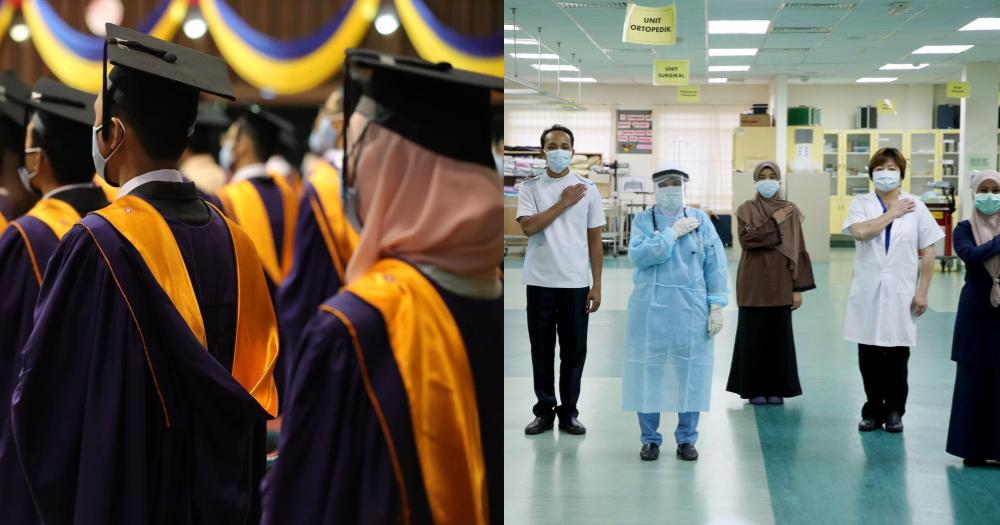Follow us on Telegram for the latest updates: https://t.me/mothershipsg
At least 30 of the “best and brightest” medical graduates from Universiti Malaya (UM) leave Malaysia for Singapore as a result of unresolved healthcare worker issues at home, said Dr Adeeba Kamarulzaman, the former dean of the UM medical faculty, Malaysiakini reported.
Disheartening affairs
In a Twitter post dated Dec. 22, Adeeba said that every year, the medical faculty of the university loses its top graduates to Singapore, despite having spent almost RM1 million (S$305,000) on training for each student.
She was responding to an article by Codeblue, Kuala Lumpur-based public policy research centre, on the need to improve conditions of emergency departments (ED) in hospitals for both patients and staff alike.
She cited the lack of posting opportunities and clear training pathways as reasons for the brain drain.
She also commented that Malaysian medical officers are apparently being sent to the UK as well to help plug the manpower shortage of their healthcare system, the National Health Service (NHS).
because of a lack of posts and clear training pathways. Each year UM loses at least 30 of our best & brightest to 🇸🇬 (remember, it costs us almost 1M per student to train ya) and now we are also apparently going to help plug the NHS shortage by also sending our MOs to 🇬🇧.
— Adeeba Kamarulzaman (@ProfAdeeba) December 22, 2022
Adeeba, also an internationally-renowned infectious diseases expert, was referring to the Memorandum of Understanding (MOU) signed in November 2021 between the governments of Malaysia and the UK, where Malaysian healthcare workers are able to undergo training in the UK and work for the NHS.
Others have echoed similar views, such as Lim Wei Jiet, the co-founder of the Malaysian United Democratic Alliance (Parti Muda), who said that he has peers from the UM medical faculty who left the country for Singapore and Australia.
So many of my peers from UM Medic Fac have left to serve in Singapore & Australia since graduation. Has been happening for years.
— Lim Wei Jiet (@lim_weijiet) December 22, 2022
Very disheartening state of affairs. https://t.co/IgDWYgGBZs
A gynaecological oncologist who teaches at the UM medical centre also tweeted that she was “disheartened” at the brain drain, questioning if anything can be done to mitigate the situation.
Just finished teaching some of our brightest medical students in UM.I was so disheartened to know that 30 of them will be leaving us for Singapore to serve as houseman/ interns there.
— YL Woo (@YinLWoo) December 22, 2022
Isn't there anything we can do to prevent this brain drain of our best medical graduates?
Why the brain drain?
Many junior doctors hired on contract with Malaysia’s Ministry of Health had previously staged protests in July 2021 due to the lack of career opportunities, job security and progression prospects.
Following the protest, the ministry announced that it was funding up to 3,000 spots for further study programmes, allowing contractor doctors and dentists to further their studies and become specialists, according to Malaysiakini.
Thread of nationwide #HartalDoktorKontrak. This is just the beginning! pic.twitter.com/3PZtVpUPG0
— avenfauzi △⃒⃘ (@avenfauzi) July 26, 2021
According to a report by Says, the contract position model for doctors was introduced in 2016 to address the influx of medical graduates as well as the authorities’ inability to provide opportunities for medical officers.
These doctors would be given a four-year housemanship contract with public hospitals, but were only offered an extension of contracts later, rather than being converted to full-time staff.
As a result, the majority of contract doctors do not receive the same benefits and salary as their full-time counterparts. To make matters worse, the contracts make it challenging for them to continue their training to become specialists. These specialisation programmes can take up to four years.
Need for resilient healthcare system
In her Twitter thread, Adeeba also highlighted that junior doctors should not be blamed for leaving Malaysia to seek better opportunities elsewhere because the local healthcare system was “failing them”.
She reiterated that it was challenging to expect a “resilient and world-class health system” when the issue of brain drain remained unresolved, for both doctors and nurses alike.
According to the CNA, some 30,000 doctors are expected to still be in their contracts by 2025. Malaysia’s health ministry estimated that around RM3.4 billion (S$1.04 billion) would be spent to create 11,296 more permanent positions starting from 2022 until 2025.
Related articles
Top images via UM & Getty/Alex Liew
If you like what you read, follow us on Facebook, Instagram, Twitter and Telegram to get the latest updates.
